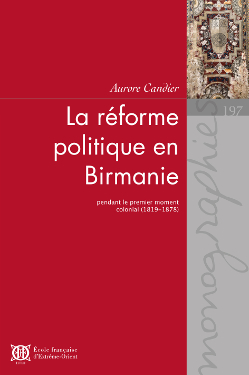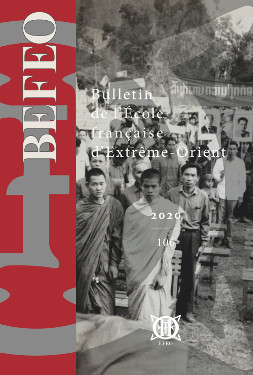History

The Indochina Years
The École française d'Extrême-Orient (EFEO), or French School of Asian Studies, was founded in 1898 in Saigon as the Mission archéologique d'Indo-Chine. The institution was created on the joint initiative of the Oriental Studies section in the French Academy of Inscriptions and Belles-Lettres and the colonial government of what was then French Indochina, the former envisaging scholars working onsite in Asia - along patterns already established by the French institutes in Athens, Rome, and Cairo - whereas the latter aimed to establish an authority that would be responsible for the inventory and preservation of the cultural heritage of Indochina.
In 1900 the Mission archéologique was renamed École française d'Extrême-Orient, and in 1902 the School headquarters were removed to Hanoi, with its main missions defined as archaeological exploration, collection of manuscripts, preservation of monuments, inventorying of ethnic groups, linguistic studies, and the study of the history of all Asian civilizations from India to Japan. To this end an ambitious academic programme, a library and a museum - which has since become the Vietnamese National Historical Museum - were put in place at the headquarters. Other museums followed: at Da Nang, Saigon, Hue, Phnom Penh, Battambang, and elsewhere. In 1907 the EFEO was assigned responsibility for the conservation of the Angkor archaeological site. This early phase of EFEO's work is still renowned for the contributions of many distinguished Orientalists: Paul Pelliot, Henri Maspero, and Paul Demiéville in Chinese studies; Louis Finot and George Cœdès in Indochinese epigraphy; Henri Parmentier in archaeology, Paul Mus in the history of religion, among many others.
The School's development after 1945
After 1945 a new period opened for the EFEO. Despite the war, and thanks to a real desire for scholarly cooperation with the newly independent states in the area, its members continued their work in continental Southeast Asia: ethnology, Buddhist studies, studies of language, literature, and above all archaeology, with huge reconstruction sites among the monuments of Angkor using the newly developed method of anastylosis. In 1957 the School was obliged to leave Hanoi, and finally, in 1975, Phnom Penh. During this troubled period the EFEO dedicated itself to widening its range of activities and developing new scholarly collaborations. In India, a permanent center was opened in Pondicherry in 1955 to carry out studies in Shivaite literature and the history of the art of the southern part of the subcontinent; later a branch of this center was opened in Pune. During the late 1950's a center was established in Jakarta for archaeologists and specialists in religious epigraphy. In Japan in 1968 the Hobogirin Institute in Kyoto brought together specialists in Chinese and Japanese Buddhism, and, a few years later, a center was established in Chiang Mai for the study of the Buddhism of Southeast Asia. Distinguished scholars from this period include, among others, Jean Filliozat in Indian studies, Rolf A. Stein in Chinese and Tibetan studies, Bernard Philippe Groslier in the archaeology of Angkor, Charles Archaimbault in Laotian ethnology, and Maurice Durand in Vietnamese studies.
The EFEO in the 21st century
The end of the war and return to a degree of stability in Southeast Asia allowed the EFEO to reestablish itself in the region, in response to requests by several local academic and political authorities. The Ecole first returned to Cambodia in 1990, after the restitution of its former real estate in Siem Reap and the revival of archaeological and conservation work at Angkor. Three years later came the opening of a new Centre in Vientiane, followed by Hanoi where the EFEO acquired a new building and library and engaged once again in research and publication in the fields of history, anthropology and epipraphy. This return to the institution's roots did not slow the opening of new horizons, both geographical and thematic: new Centres were opened in partneship with local institutions in Kuala Lumpur (National Museum), Hong Kong (Chinese University of Hong Kong), Taipei (Academia Sinica), Tokyo (Toyo Bunko), Seoul (University of Korea), and finally Beijing (Chinese Academy of Sciences); in terms of research priorities, the period saw a marked opening to the Social Sciences and contemporary Asia: study of Indian commercial networks, the modern and contemporary demography of highland continental Southeast Asia, ehtnic conflict and issues of national and regional integration of minorities, the dynamics of religion in the contemporary societies of China, Thailand and Indonesia, the politics of national heritage conservation. At the beginning of the 21st century the EFEO participates actively in the digital transformation of humanities research and the growing internationalisation of Asian studies, and occupies a central position in the network of high-level academic partnerships in Asia and Europe developed since 2007 under the European Consortium for Asian Field Study initiative (ECAF).
Suganya Anandakichenin (PI), Giovanni Ciotti (University of Hamburg) and S. A. S. Sarma (EFEO, Pondicherry) lead this ten-month project (August 2021-May 2022) aims to clean, digitize, and catalogue a portion of about 180 manuscripts belonging to two collections (called "Kalliṭaikuṟicci" and Villiampākkam).
These manuscripts, many of which date from the mid-19th century, contain texts of various genres, in Tamil, Sanskrit and Manipravalam, written in Tamil and Grantha. Previously neglected, these relics of the past will give us a clear idea of the reading and study choices of a Tamil and Vishnu Brahmin scholarly family from the 19th century onwards. Work on the project is currently underway at the EFEO Center in Pondicherry.

The winner of the 2021 French-Language Book Prize is "La réforme politique en Birmanie pendant le premier moment colonial (1819-1878)" by Aurore Candier, published by the EFEO !
The collection of periodicals in the Leroi-Gourhan collection includes 30 titles, the most complete of which are 民俗藝術 Minzoku geijutsu and 工藝 Kōgei, a publication co-edited by Yanagi Muneyoshi, the specialist in folk arts and "mingei studies". This monthly journal, with a print run of only 1000 copies, devoted to craftsmanship, materials and tools used in the making of objects, is rare and precious.
As part of the Kyoto lectures, DAIMARU Ken (Paris University) presents: "Health and Modern Warfare. Locating Medical History in Japan's Long Nineteenth Century".
19 July, 6pm (Japan time) in hybrid format or only on the Zoom platform. The password for logging in will be posted on the Kyoto Center's blog and the ISEAS website on the 27th.
Légende : Portrait of an injured Japanese soldier at the Liaoyang Stage Hospital (March 1905), archives of the Academy of Medical Corps of the Japan Ground Self-Defense Force
READ READ MORE
You can also find inventories of caṃ, pāli, Siamese, Thai, thai yuan and thai lü manuscripts, and Cambodian paper manuscripts, which you can browse on the EFEO archive website and on Calames.




